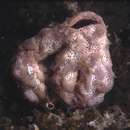tr
kırıntılardaki isimler


Exostoma is a genus of sisorid catfishes native to Asia. These species are distributed in the Brahmaputra drainage of north-eastern India, and east and south to the Salween drainages in Burma. E. berdmorei is found in the Sittang and Salween drainages in Burma.[1] E. labiatum is known from the Brahmaputra drainage in north-eastern India, but has also been recorded in the Salween drainage in Burma, the Ayeyarwady drainage in China, and the Brahmaputra drainage in Tibet and Burma.[1][2] E. stuarti is from the Ayeyarwady River of Burma and India; however, it has not been collected since its original discovery.[1][3] E. labiatum is found in mountain rapids.[2]
In a 2007 checklist of sisorid and erethistid catfishes, Thomson lists E. stuarti and E. vinciguerrae as valid species.[1] In a 2007 checklist of catfishes, Ferraris lists these two species as species inquerendae, noting that these species are either treated as valid or as synonyms of E. labiatum.[4]
The following species are currently recognized in the genus Exostoma:
Exostoma is distinguished by having a continuous groove behind the lips (post-labial groove), the gill openings not extending onto the underside (venter), homodont dentition of oar-shaped, distally flattened teeth in both jaws, the tooth patches separated in upper jaw, and 10–11 branched pectoral rays.[1] The head is depressed with a broadly rounded snout. The body is elongate and flattened ventrally to the pelvic fins. The eyes are minute, dorsally located, and under the skin (subcutaneous). The lips are thick, fleshy, and papillated. The teeth are small to large, moveable, oar-shaped, flattened distally and directed posteriorly in distinct patches.[1]
E. stuarti is recorded to grow to 5.6 centimetres (2.2 in) SL.[3] E. berdmorei and E. labiatum grow to about 10–11 cm (3.94–4.33 in) TL.[9][2]
{{cite journal}}: CS1 maint: uses authors parameter (link) Exostoma is a genus of sisorid catfishes native to Asia. These species are distributed in the Brahmaputra drainage of north-eastern India, and east and south to the Salween drainages in Burma. E. berdmorei is found in the Sittang and Salween drainages in Burma. E. labiatum is known from the Brahmaputra drainage in north-eastern India, but has also been recorded in the Salween drainage in Burma, the Ayeyarwady drainage in China, and the Brahmaputra drainage in Tibet and Burma. E. stuarti is from the Ayeyarwady River of Burma and India; however, it has not been collected since its original discovery. E. labiatum is found in mountain rapids.
In a 2007 checklist of sisorid and erethistid catfishes, Thomson lists E. stuarti and E. vinciguerrae as valid species. In a 2007 checklist of catfishes, Ferraris lists these two species as species inquerendae, noting that these species are either treated as valid or as synonyms of E. labiatum.
Exostoma es un género de peces de la familia Sisoridae en el orden de los Siluriformes.
Las especies de este género son:[1]
Exostoma Blyth, 1860 è un genere di pesci gatto della famiglia Sisoridae originario dell'Asia.
Questi pesci si distinguono per avere una scanalatura continua dietro le labbra (scanalatura post-labiale), le aperture della branchie che non si estendono sul lato inferiore, dentatura omodonte[1] a forma di remo disposti in entrambe le mascelle. lI muso è ampiamente arrotondato, mentre il corpo è allungato e appiattito ventralmente alle pinne pelviche. Gli occhi sono piccoli, localizzati dorsalmente e sotto la pelle. Le labbra sono spesse, carnose e papillate.[2]
Queste specie si trovano lungo il bacino del fiume Brahmaputra nell'India nord- orientale e in direzione est e sud nel bacino del Salween in Birmania. Alcuni esemplari di E. berdmorei si sono trovati nel bacino del fiume Sittang e Salween in Birmania.[2] Gli esemplari di E. labiatum sono più comuni nel bacino del Brahmaputra, fino ad arrivare anche in Tibet, ma è stato anche ritrovato nel bacino del Salween e nell'Irrawaddy Gli esemplari di E. stuarti provengono dal fiume Ayeyarwady della Birmania e dell'India; tuttavia, non è stata ancora confermata la sua origine. Gli esempari di E. labiatum si trovano nelle rapide di montagna.
Ci sono attualmente 9 specie riconosciute in questo genere:
Exostoma is een geslacht van straalvinnige vissen uit de familie van de zuigmeervallen (Sisoridae).
Exostoma is een geslacht van straalvinnige vissen uit de familie van de zuigmeervallen (Sisoridae).
Загальна довжина представників цього роду коливається від 3,5 до 11 см. Зовні схожі на сомів роду Euchiloglanis. Голова сильно сплощена, морда широка й округла. Очі крихітні, розташовані зверху голови. Губи товсті, м'ясисті. Має безперервну канавку за губами. Є 4 пари коротесеньких вусів. Рот помірно широкий. Зуби веслоподібні, дистально сплощені на обидвох щелепах. Зяброві отвори не тягнуться до нижньої частини голови. Тулуб подовжений і сплощений знизу. Хвостове стебло звужене. Спинний плавець невеличкий. Грудні плавці мають 10—11 розгалужених променів. Черевні плавці поступаються останнім. Жировий плавець довгий. Анальний плавець короткуватий. Хвостовий плавець з розрізом, лопаті на кінцях загострені.
Забарвлення коричневе або чорне.
Це демерсальні риби. Зустрічаються в гірських річках, на швидкій течії і кам'янистих ґрунтах. Активні переважно у присмерку. Живляться личинками комах і донними організмами.
Мешкають у водоймах Індії, Китаю, Таїланду і М'янми — в басейнах річок Брахмапутрі, Іраваді і Салуїн.